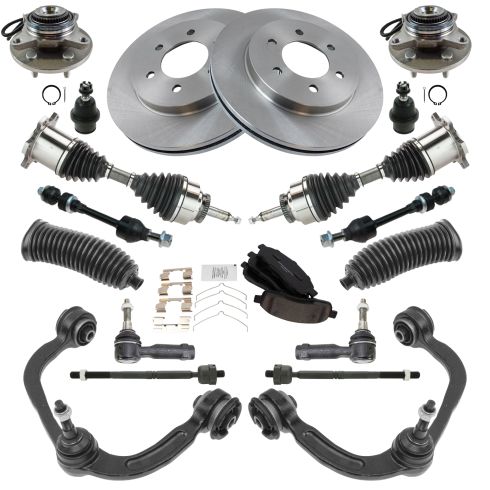1ASFK06117-Ford F150 Lincoln Mark LT Front Steering, Suspension, & Brake Kit DIY Solutions SUS04205

Replaces
2007 Ford F150 Truck 4 Wheel Drive with 6 Lug Wheels Front Steering, Suspension, & Brake Kit DIY Solutions SUS04205

Product Reviews
Loading reviews
5.00/ 5.0
4
4 reviews
October 7, 2019
Everything was great except for the inner tie rods but they promptly sent me replacements once they were notified of the defective parts. Very professional and happy to make things right. Will be using again for future part purchases
Front end suspension rebuild
September 22, 2020
This kit had everything I needed for my complete front end suspension aside from springs and shocks. It all came in one kit that's awesome less work for me finding them all one by one. Reasonable price and parts seemed beefier than factory ones. I am fully satisfied with the end result, there was a noticeable difference in ride quality of my truck nice smooth ride. I would definitely recommend this kit. As a side note it would not be a bad idea to include the front shocks and springs in the kit as another opportune as well.
Fast shipping and great parts
October 8, 2020
Got them fast and they fit just like they said it would 1a auto is the best place for auto parts
just what I needed
October 23, 2020
my old 2006 ford f150 drives like a new truck. All parts fit like a glove.
I will now keep her instead of selling here.The new shocks I bought from 1A and new tires I got a new truck.
Thank you for good parts at a good price.
John L.
Customer Q&A
I have a Ford with a 6 inch lift will these parts still work for my truck?
July 12, 2018
10
Hello.
All the parts we carry are listed to fit unmodified vehicles only. Thank you!
July 12, 2018
Adam G
Does this kit include front hubs?
October 2, 2020
10
Hello,
This kit is shown to include the front hubs. Thanks!
October 2, 2020
Adam G
10
Yes it does
October 4, 2020
Matt I
will this kit work with 2.5" Rough Country struts and springs?
April 21, 2021
10
The parts we have are unable to work for vehicles with lift kits.
April 21, 2021
Emma F
Ford is a registered trademark of Ford Motor Company. 1A Auto is not affiliated with or sponsored by Ford or Ford Motor Company.
See all trademarks.




























